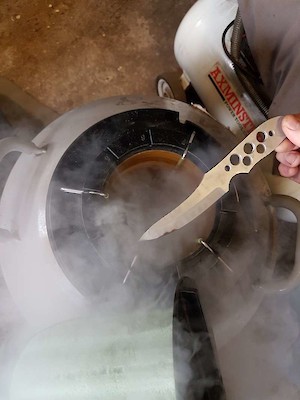Stainthorp Custom Knives
Steel
I am happy to work in a fairly wide variety of materials, and part of the enjoyment for me is experimenting with new steels in particular. Over the years I have settled on several blade steels that have proved to be excellent, consistent in supply and results, and that cover a multitude of uses. Part of the knifemaking conundrum is that no steel is the pinnacle in all the desirable blade characteristics, (edge holding, toughness, stain resistance, ease of sharpening), but by offering a variety choices, the materials can be optimized to meet your specific needs. I Rockwell test every blade to ensure the perfect degree of hardness and that your knife is as good as it can possibly be.
The steels I offer as standard are:
RWL34 - For many years now this has been my go-to stainless steel for all round performance. A Swedish powder version in the same family as Japanese ATS-34 or CPM154 from the US, it gives excellent and very consistant performance, and although you could find something to surpass it in a particular facet, as a balance of all factors, it is an excellent choice.
14C28N - Sandvik Steels upgrade to the salwart 12C27. This steel is fantastic for someone who uses their knife a lot, as it gives improved corrosion resistance and it is possibly to nicest to sharpen out of all the steels I've used, whilst having a very stable edge which it holds well.
Niolox - A reletively new addition to the line up, this is a steel that is impressing me more and more. It stands out in edge-holding and whilst I'm still putting it through it's paces, it looks like becoming a firm favourite for extended use. It doesn't take a finish like RWL34 or have the ease of sharpening/corrosion resistance of 14C28N, but it cuts like few others and if you're competent at sharpening, it could be the steel for you.
Damasteel - The trade name for stainless pattern welded steel made via a powder steel process in Sweden, Damasteel is stunningly beautiful stuff and will make any knife into a unique work of art. It is essentially RWL-34 and 12C27 in the mix, and so it performs very much in line with those steels. Available in many patterns, it comes at a premium cost but your knife is guaranteed to be one of a kind and a piece to treasure for generations.
O1 - A carbon steel, and a firm favourite of bushcrafters and outdoorsmen. Makes a tough knife, and scores well in all areas aside from corrosion resistance. As with any carbon steel, there is a degree of maintenance required and staining/patination are to be expected.
Others - I've also worked with several of the CPM steels, (3V, 4V, 10V, S30V, S35VN, S90V, S110V) in addition to Nitrobe-77, ZDP189, Z-wear, VG10, D2, A2...please get in touch to discuss your needs.
Handle Material
These basically fit into two categories, natural and man-made. For hard use knives that will see use bordering on abuse, the indestuctable man-made laminates are top dog. Micarta is made from any material that will absorb epoxy resin, but most commonly canvas (coarse) or linen (finer). This material is saturated with resin and compressed to form an extremely hard wearing handle that is available in a wide variety of colours and finishes. G10 is made in a similar way, but uses a glass fibre cloth as the base material. Both are impervious to the elements and give a bombproof knife handle.
Natural materials are vast and varied, but most often are wood, horn or antler. These can be incredibly beautiful, but also susceptable to changes in humidity and temperature that can result in warpage or cracking in extreme cases. Where possible, I like to use desert ironwood as it is naturally so dense that it has very good stability, and other timbers I always recommend having professionally stabilised to fully seal them from the elements. Please note that good quality stag antler has become extremely hard to find as the densest stuff was always imported sambar and chital from India, but that supply was stopped some years ago and supply is very limited.
Have a browse through the galleries and please get in contact for more information.


